AMD Radeon HD 6850 Overclocking Roundup: Asus, XFX, & MSI
by Ryan Smith on November 8, 2010 12:40 AM ESTOverclocking: Performance, Power, Temperature, & Noise
Half of our results focus on our 6850s at their stock clocks, but the other half of our results focus on the card when it comes to overclocking. As a lower clocked Barts card, 6850 cards not binned for poor maximum clocks should have a fair bit of overclocking room as AMD intended for the design to hit 900MHz+. The 6850’s power efficiency pretty much has to go out the window here, but in return we can capture some significant performance gains.
| Overclocking Results | ||||||
| Stock Clock | Max Overclock | Stock Voltage | Max Overclocked Voltage | |||
| Radeon HD 6850 Reference | 775MHz | 940MHz | 1.094v | 1.172v | ||
| XFX Radeon HD 6850 | 775MHz | 940MHz | 1.148v | 1.172v | ||
| MSI R6850 OC | 820MHz | 960MHz | 1.148v | 1.22v | ||
| Asus EAH6850 | 790MHz | 960MHz | 1.148v | 1.22v | ||
When overclocking, we found 3 things:
- All of the cards could hit 850MHz core at stock voltage
- All of the cards could hit 940MHz core at 1.172v, the 6870 load voltage
- We had to give the cards significantly more voltage to get above 940MHz. This culminated at 1.22v on the Asus and MSI cards for 960MHz
Based on these results we went ahead and benchmarked the Asus card at 850/1150, 940/1150, and 960/1150 to showcase the performance at these overclocks, while capturing data for all of the cards at 1.172v, and the Asus and MSI cards at 1.22v.
While it’s possible to hit 960MHz with enough voltage, in practice it’s not worth the effort. The Asus and MSI cards jumped in power consumption, temperature, and noise by around 20W, 3C, and 2dB each, for a performance difference of under 2%. On a higher-end card where performance is the only attribute that matters this wouldn’t really matter, but we would not consider this a useful tradeoff on a petite card like the 6850.
As for memory overclocking, we hit at solid wall at 1150MHz as none of our cards could do 1200MHz without artifacting. However 1150MHz didn’t trigger performance degradation due to error correction-induced retransmission, so it looks to be a safe frequency for all cards. The limit we believe lies solely with the memory controller, which was a conscientious decision by AMD to trade memory clocks for a smaller die. As a result the controller reaches its limit before we can even push the 5GHz GDDR5 to spec.
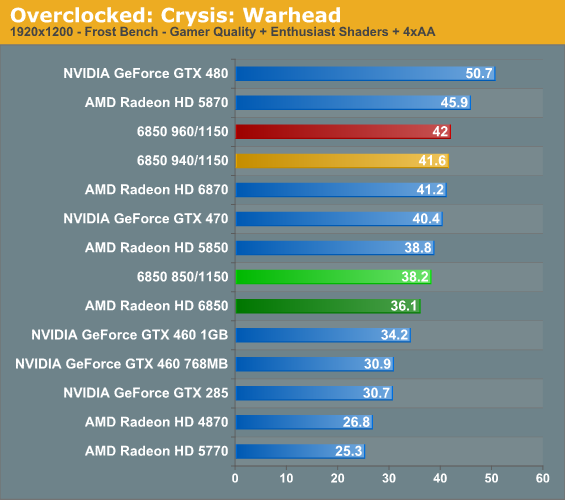
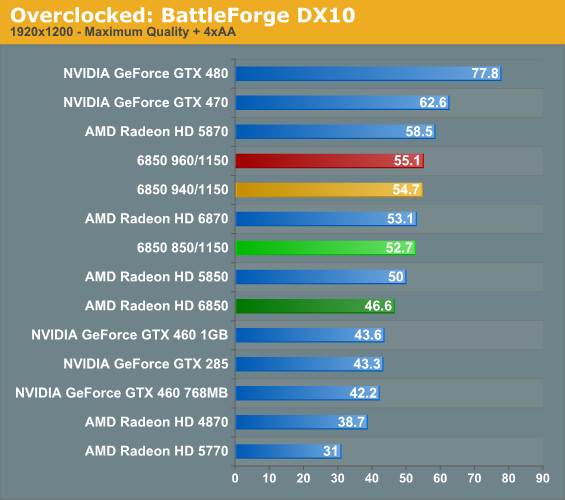


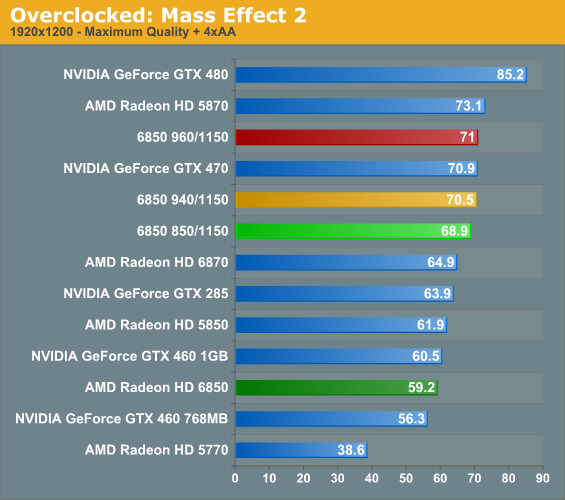
Something that caught us completely off-guard in our results is just how well the overclocked 6850 did. Even at the “mere” speed of 850/1150, it’s faster than the 6870 in 3 out of our 5 games; and the 6870 still has a core clockspeed advantage and more SIMDs! The advantage for our overclocked 6850s is that the memory clock of 1150MHz (4.6GHz effective) is faster than the 6870’s memory clock of 1050Mhz (4.2GHz effective), and this looks to be the reason for the difference. Based on all the data we have, Barts looks to be memory bandwidth starved in around half the games we use. From this it looks like a good memory overclock is going to go a long way on the 6850 and 6870 towards improving performance.
As for how much of an overclock is necessary, this depends on the game. When Barts is memory bandwidth starved, the 940Mhz and 960Mhz memory overclocks provide only a small boost; while on shader-bound games like Crysis there’s a very tangible benefit. Combine the memory overclock with a 940Mhz core overclock and the 6850 can meet or beat the 6870 every single time. The voltage increase necessary to achieve this core overclock comes at a price however.

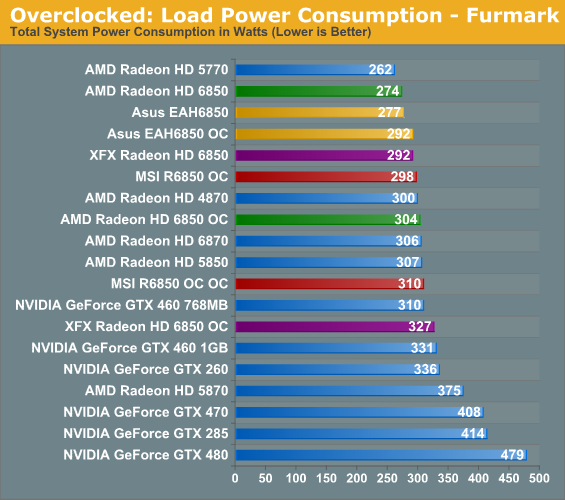
Starting with power consumption, the voltage increase necessary for 940MHz is around 20W-30W under FurMark for our reference and near-reference clocked cards, and less for the MSI card since it already has a notable factory overclock. If nothing else, 1.172v gives up all the power advantages over the Radeon 5850, though as we’ve seen it pays off with a very notable performance advantage over the 5850.
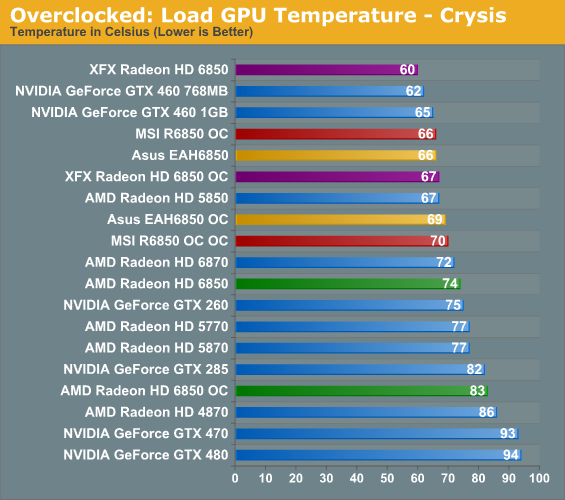

For the partner cards in today’s roundup, the temperature runup from overvolting isn’t too bad, with the worst card only hitting 81C under FurMark and becoming progressively cooler from there. However the reference 6850 is an entirely different story: it hits 93C under FurMark, which is hotter than what we’re comfortable with for Barts, particularly since it’s brand new. If reference-style cards show up on the market, we would not recommend overvolting them, at least not to 1.172v. Meanwhile the XFX card with its focus on temperature tops this chart, still only hitting 74C under FurMark. The cooling on this card is so good that we suspect the VRMs will burn up long before the GPU will when overvolting.
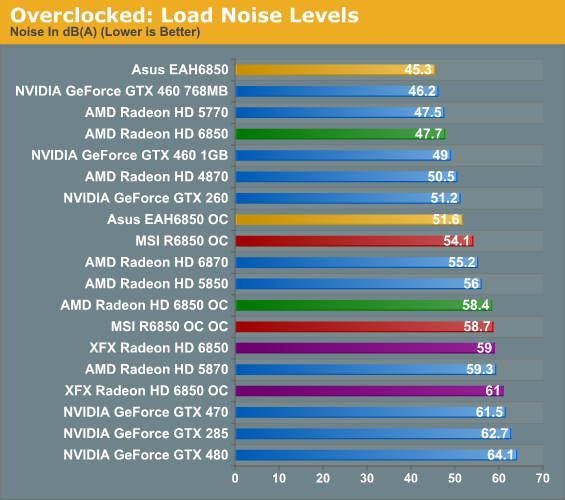
Finally we come to noise. We suspect many buyers will be alright with the power and temperature increases so long as noise remains manageable, so what we have is a mixed bag. Throwing out the reference 6850, we’re left with the XFX card at over 60dB, and while XFX’s focus on temperatures is commendable, it ends up being shortsighted by making the card exceptionally loud here. This is followed by the double-overclocked MSI card, which at 58.7dB is over 3dB louder than the 6870, but is only encroaching on the 5870. It’s too much noise for the performance, but compared to first-gen 40nm cards it’s not the end of the world.
This leaves us with the Asus card. While it does jump by 6dB due to our overclocking, it had such a massive lead at stock that this only makes it about as loud as the GTX 260 and Radeon HD 4870. The idea of a near-silent card has gone out the window at this point, but we would consider it a very manageable level of noise for the performance offed with the 940/1150 overclock. Certainly it’s the most balanced of the cards, as it sacrifices only little in the way of cooling (78C in FurMark) for the lower level of noise generated.










93 Comments
View All Comments
Mr Perfect - Monday, November 8, 2010 - link
AT normally tears the cooler off to examine the card, and then dissects the cooler itself too. Neither 6800 article has done this though. It should be an even bigger priority when we're comparing non reference cards that are competing purely on their unique designs. Are these cards on loan? Do they have to be returned in the same condition they where received? If so, I say just ship them back without reviewing them. :PI just came from XBitLabs, where they did a proper teardown of both a stock 6850 and 6870, and that Asus card looks a lot like the stock 6870 board. It has the two top mounted PCIe power connectors, and the VRMs appear to be between the GPU and IO ports. I would not be surprised if it really was a 6870 PCB. Check it out!
khimera2000 - Monday, November 8, 2010 - link
I appreciate the review, it looks alot less of a hot article as the last one, and its clear that a good amount of effert went into this article just by the comments AT left, and the way the article was written.I was also wondering when will the review of the higher end 6xxx card be availabe?
Cali3350 - Monday, November 8, 2010 - link
A lot of Doom and Gloom here about the OC cards. Let me try and tell you, Ryan and Anand, what I think the people want as a majority:1. Never use OC'd cards in a initial review. Ever. You guys, quite frankly, should have known this and the flak you are getting for using it is deserved imo. Nvidia conned you guys into making their cards unfairly better than the competition in the main review article of a major launch and you fell for it. That article will likely get much more readership than any roundup, and is likely to be looked up in higher numbers down the line. You played that one like a PR branch of Nvidia and you made people angry (imo rightly so). Dont ever do this again. Do not review anything but stock clocks in your GTX 580 review tommorow, and dont you dare use a overclocked anything in your upcoming Cayman review either.
2. Always use OC'd cards in your comparisons. This a COMPARISON article of AIB's and the products they are offering. Ofcourse we want to see how a overclocked 460 compares to a overclocked 6850, this is the article where we go over what is out there in the retail market, not what is officially supplied by the creators. This article loses a lot of value without a 460 OC'd in it.
Launch articles = what we are getting from the creators of the product.
Comparison articles = what we are buying in the real world.
I love this site, and I do not think your biased, but I wont defend you over the 68XX review either.
AnandThenMan - Monday, November 8, 2010 - link
I agree with what you are saying here. The problem is, the genie is out of the bottle. Anandtech should not let the 68xx review stand as is, the FTW results should be removed, and all references to it. And if that is not done, then overclocked AMD cards must be included in all future reviews, no exceptions. In fact, Anandtech should accept a hand picked, delivered to their door card from AMD.If neither are done, then I would question all results published here, there is a credibility problem to say the least. You can't start picking and choosing how reviews are done depending on the hardware. That is exactly why policies are in place. Sadly that policy was ignored.
Jamahl - Wednesday, November 10, 2010 - link
This.Ryan Smith and Anand deserve the fallout over this. They brought it on themselves as does any site that shifted their goalposts in the past few weeks.
Dwebtron - Monday, November 8, 2010 - link
I'm super interested in this one, as I'm holding on to mine... but it never appears in the charts?RaptorTek - Monday, November 8, 2010 - link
Its really the immature fanboys that cant handle seeing their company/card lose that make a stink about including the FTW OC cards in the mix. It makes them feel insecure about themselves and their decisions on being a fanboy for which they decided to spend their hard earned money on. When it comes down to it, the more data we have available the better the decisions we can make on what really is the best hardware for the price. Having the FTW 460 1gb in the stock 6850/6870 article was good since it showed what the contending cards possibilities were. Including the FTW 460 1gb in this OC article would of been even more relevant for side by side comparisons. I would hope Anandtech can see that even if some of "the readers" complain about these things, its really for the best in the logical comparison of these cards.
El_Capitan - Monday, November 8, 2010 - link
Indeed. Why would any logical person WANT LESS data?Fanboy: My HD 6850 that I bought for $189.99 is better than a stock GTX 460 1GB you purchased for $239.99, and overclocks higher!
Realist: I bought by GTX 460 1GB for $189.99 and it overclocks to 1015MHz without unlocking the voltage, what are you talking about?
Fanboy: AnandTech doesn't show that, so it's not relevant!
Realist: You're retarded.
Fanboy: You're an Nvidia fanboy!
Realist: I also own a HD 5870 2GB that I bought for $250.
Fanboy: Yeah, right, whatever!
Realist: ...
Fanboy: Stupid fanboys, they think they know everything.
Realist: :Facepalm:
AnandThenMan - Monday, November 8, 2010 - link
You both completely missed the point, and sounded childish and fanboy-ish in the process.jsrivo - Monday, November 8, 2010 - link
From what I've read, the OCed cards are reaching 800-900MHz on average, and claiming that 1015MHz is realistic for most buyers is a bit fanboyish, in my opinion.